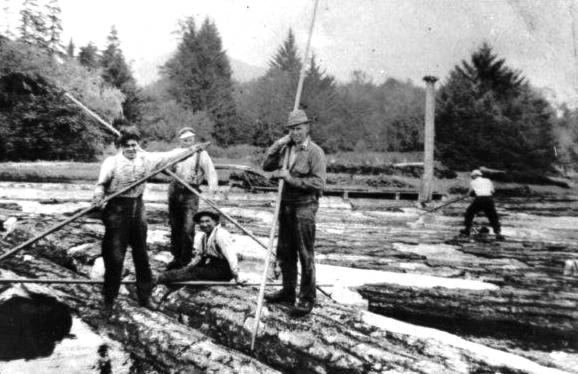Elida Peers | Contributed
Through Roy Hill, who shared this photo with us when he was running a small store in Saseenos, we learn that for a time his family earned their living by being nimble-footed on the water.
In the photo’s forefront are Roy Hill and his brother, with Pete Mitchell sitting on a log and Frank Elliott standing behind, in the San Juan River, as they took a pause from booming logs.
Nimbleness of foot was a must – they spent their days leaping from one floating log to another, wearing caulk boots, and wielding their pikepoles.
Visitors to Port Renfrew nowadays might recognize the north side of the San Juan in the background, on the ocean side of the Deering Trestle.
The booming crews were hired to sort the logs into booms bounded by cables for towing by tugboat to coastal sawmills.
Besides their trusty pikepoles, the boom men needed wrenches, sledgehammers and axes to deal with rusted bolts. Most of all, they needed agility, as if they didn’t stay on the surface of the rolling logs, they would not only get a cold dunking, but possible injury.
While Roy Hill and his wife Barb later bought a home in Broome Hill and ran the store built in Saseenos in the 1940s by Walter Bickford, he regaled us with tales of early days in Port Renfrew:
“We arrived on the Maquinna in May 1945 from Salmon Arm – from the desert to the rainforest. I found out the water was salty by falling in between the float bridge and the canoe. We were first in a one-room school and then in a two-room Superior school … There was a weekly movie for 25 cents. We had a telephone, everyone was on one line, each with their own signal ring. As teenagers we crashed the dances and found ways to find beverages … Smelt fishing was done with a long pole and a dip net … you dipped out and hoped for a full net but sometimes only got rocks. We’d get wet to the shoulders, come back to a big beach fire to warm up, and cook the smelt over the fire on a stick … when I was 18, I left Port Renfrew, joined the Airforce in Victoria and went to boot camp in Montreal … what a culture shock.”
•••
Elida Peers is the historian of the Sooke Region Museum.
